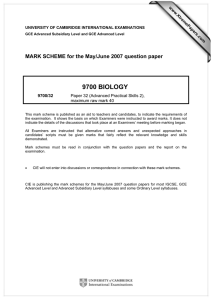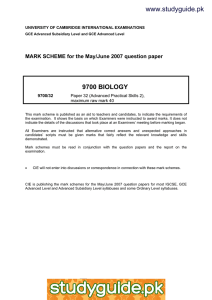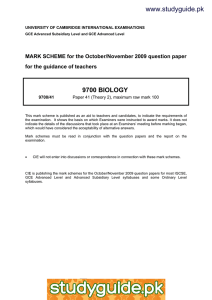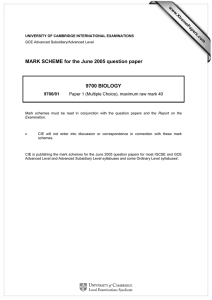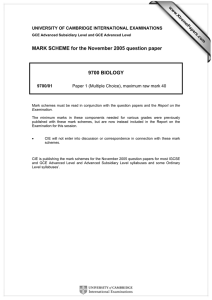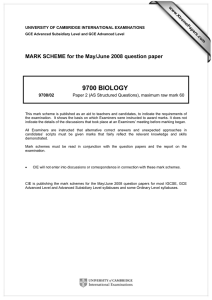9700 BIOLOGY MARK SCHEME for the October/November 2009 question paper
advertisement
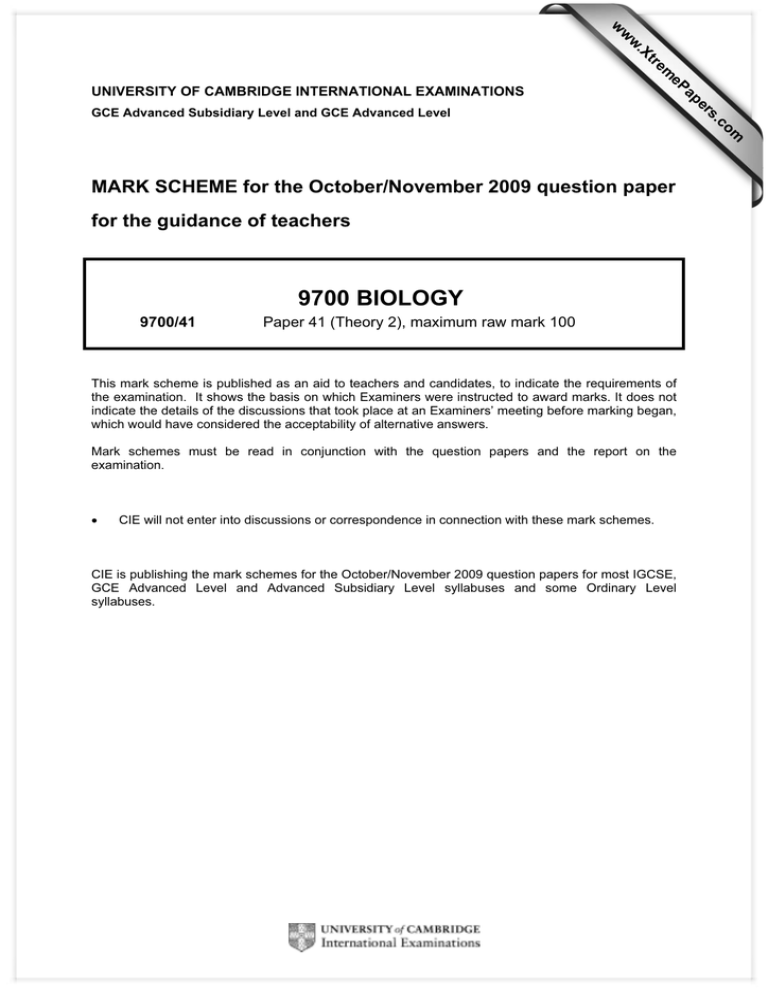
w w ap eP m e tr .X w UNIVERSITY OF CAMBRIDGE INTERNATIONAL EXAMINATIONS for the guidance of teachers 9700 BIOLOGY 9700/41 Paper 41 (Theory 2), maximum raw mark 100 This mark scheme is published as an aid to teachers and candidates, to indicate the requirements of the examination. It shows the basis on which Examiners were instructed to award marks. It does not indicate the details of the discussions that took place at an Examiners’ meeting before marking began, which would have considered the acceptability of alternative answers. Mark schemes must be read in conjunction with the question papers and the report on the examination. • CIE will not enter into discussions or correspondence in connection with these mark schemes. CIE is publishing the mark schemes for the October/November 2009 question papers for most IGCSE, GCE Advanced Level and Advanced Subsidiary Level syllabuses and some Ordinary Level syllabuses. om .c MARK SCHEME for the October/November 2009 question paper s er GCE Advanced Subsidiary Level and GCE Advanced Level Page 2 Mark Scheme: Teachers’ version GCE A/AS LEVEL – October/November 2009 Syllabus 9700 Paper 41 Section A Question 1 (a) (b) Expected Answers Marks 1 species threatened with extinction ; 2 numbers reduced to critical level / population too small ; 3 such low numbers that reproduction is affected ; 1 (maintain colony) in zoo ; 2 captive breeding (programme) ; 3 assisted reproduction ; e.g. IVF 4 educate public ; 5 national parks / conservation areas ; 6 habitat protection ; 7 ban, hunting / poaching ; [2 max] [4 max] [Total:6] 2 (a) (b) 1 population increases slowly at first / ref. lag phase ; 2 (because) adjusting to pond environment ; 3 (then) steep increase / log phase / exponential increase / rapid growth or reproduction phase ; 4 (because) abundant food source / named other factor ; 5 stationary phase ; 6 fall in population size / death phase / decline phase ; 7 (due to) predation / build up of waste ; 8 competition for named resource ; e.g. food shortage 9 idea of further increase and fall / ref. population size may be cyclic ; [5 max] variation means the presence of different characteristics ; resulting in different survival rates / AW ; (leads to) reproductive, success / failure ; [2 max] [Total: 7] © UCLES 2009 Page 3 3 (a) Mark Scheme: Teachers’ version GCE A/AS LEVEL – October/November 2009 Syllabus 9700 (i) so that, the bacteria were not killed / enzymes not denatured ; (ii) 1. bacteria put into (solution of) sodium alginate ; Paper 41 [1] 2. place mixture in syringe ; 3. add drops of mixture to calcium chloride solution ; 4. calcium ions replace sodium ions (to form beads) ; 5. bacteria trapped in beads ; (b) (i) [3 max] note comparison between blue line and black line ignore references to red line - agar 1. both increase up to, 18 / 24, hours ; 2. both similar, initially / up to 18 hours ; 3. biggest difference at 24 hours / rate of increase for immobilised cells greater than free cells between 18 and 24 hours ; 4. after 24 hours immobilised cells rate decreases while free cells rate continues to increase or after 39 hours free cells rate is greater than immobilised cells rate ; 5. free cells final concentration is still lower than highest value attained by immobilised cells ; 6. use of comparative figures ; (ii) [4 max] 1. (could be) less surface area (to volume ratio) in cubes than beads ; 2. (could be) a greater diffusion distance to centre of cubes than beads ; 3. agar may be less permeable (to substrate) than alginate ; 4. something in agar may inhibit bacterial enzymes ; 5. some protease adsorbed by agar ; © UCLES 2009 [2 max] Page 4 (c) Mark Scheme: Teachers’ version GCE A/AS LEVEL – October/November 2009 (i) Syllabus 9700 82.14 / 82.1 / 82 (%) ; ; allow one mark for suitable working if incorrect answer (ii) Paper 41 [2] 1. can use alginate (beads) many times ; 2. (reduces cost of), materials / energy / labour ; 3. fewer bacterial cultures needed / less time spent immobilising bacteria ; 4. more protease produced (per hour) (using alginate) ; 5. can run fermentation for longer time ; 6. less time wasted between fermentations ; answers must imply comparison [3 max] [Total:15] 4 (a) AABBCC ; (b) if doubling of chromosomes has not occurred (c) (d) [1] 1 chromosomes would not be able to pair ; 2 because chromosomes in the two sets are not homologous ; 3 during, prophase 1 / meiosis 1; 4 (therefore) gametes cannot be produced ; 1 unable to, breed / reproduce ; 2 to produce fertile offspring ; 3 reproductively isolated ; 1 species split into two populations by (geographical) barrier ; 2 different, selection pressures / (environmental) conditions, (on the two populations) ; 3 different features, selected / advantageous ; 4 change in, gene pools / allele frequencies ; 5 (over time) become unable to interbreed ; [3 max] [2 max] [3 max] [Total: 9] © UCLES 2009 Page 5 5 Mark Scheme: Teachers’ version GCE A/AS LEVEL – October/November 2009 (a) Syllabus 9700 Paper 41 ductless gland ; secretes (hormone) into blood ; (b) (i) [2] 1. follicle, develops / matures / grows ; 2. detail follicle ; e.g. antrum / corona / theca 3. (follicle) secretes oestrogen (and progesterone) ; (ii) (c) to produce many (mature) oocytes at same time ; 2 superovulation ; 3 make harvesting easier ; 4 IVF procedure has low success rate ; (i) [2 max] a change sets off events that counteract the change / AW / example described ; [1] (ii) oestrogen inhibition of, GnRH / FSH ; [1] (i) day 9 ; [1] (ii) prevent ovulation / so oocytes can be harvested ; [1] (e) (g) [1] 1 (d) (f) trigger ovulation / description ; [2 max] 1 very little difference in percentage of pregnancies resulting in live birth ; 2 standard (slightly) more oocytes (per cycle) ; ora 3 standard (slightly) more embryos (per cycle) ; ora 4 comparative figs ; 1 (promoter needed) to ensure genes are, expressed / switched on ; 2 to produce, correct product / correct hormone / FSH ; 3 ref. human / eukaryote, gene in, bacteria / prokaryote ; [3 max] [2 max] [Total: 16] © UCLES 2009 Page 6 6 (a) Mark Scheme: Teachers’ version GCE A/AS LEVEL – October/November 2009 Syllabus 9700 (i) same band of DNA as, first / affected, child ; (ii) 1. father and mother, have normal and mutant alleles / are heterozygous ; Paper 41 [1] 2. mutant / CF, DNA is, shorter / lighter ; 3. therefore travels further ; (b) 1 outcome of test needs explanation / counsellor gives advice on options ; 2 already have one affected child to care for or problems / cost, of care ; 3 ref. termination ; 4 life expectancy increasing with improved drugs ; 5 gene therapy, not as yet successful / likely to be temporary ; 6 possibility of, pre-implantation genetic diagnosis (PGD) / artificial insemination by donor sperm (AID), on another occasion ; [2 max] [4 max] [Total: 7] 7 (a) allele different / alternative, form of a gene ; A variety of a gene dominant (allele) that always expresses itself in the phenotype when present / (allele) which influences the phenotype even in the presence of an alternative allele / AW ; (b) [2] parental phenotype ; e.g. striped / long x striped / long A wild x wild parental genotype ; e.g. AaBb x AaBb gametes ; e.g. AB Ab aB ab offspring genotypes ;; offspring phenotypes ; must be linked to genotypes accept other symbols if key used penalise once for no key but only if genetic cross works © UCLES 2009 [6] Page 7 (c) Mark Scheme: Teachers’ version GCE A/AS LEVEL – October/November 2009 Syllabus 9700 Paper 41 (i) phenotypes of Drosophila melanogaster grey body long wing grey body vestigial wing ebony body long wing ebony body vestigial wing observed number (O) 207 79 68 30 expected ratio 9 3 3 1 expected number (E) 216 72 72 24 O–E –9 7 –4 6 (O – E)2 81 49 16 36 (O − E) 2 E 0.38 0.68 0.22 1.50 [3] (ii) 2.78 ; apply ecf [1] (iii) χ 2 value represents probability of > 0.05 ; no significant difference ; (probability shows) differences due to chance ; [2 max] [Total:14] © UCLES 2009 Page 8 8 (a) Mark Scheme: Teachers’ version GCE A/AS LEVEL – October/November 2009 (i) Syllabus 9700 Paper 41 at low light intensity 1. rate of photosynthesis increases as light intensity increases ; 2. light intensity is limiting factor ; at higher light intensity 3. graph, levels off / forms a plateau / rate becomes constant ; 4. CO2 / some other factor, becomes limiting ; (ii) [3 max] 1. above light intensity of 1 rate is always higher for expt. 2 ; 2. plateau reached at lower light intensity for expt. 1 ; 3. maximum / plateau, rate is double for expt. 2 ; 4. expt 2 has much more CO2 (conc) (compared to expt 1) ; 5. CO2, no longer limiting after 4.2 in expt.2 / is limiting in expt. 1 up to 2.8 ; (b) 1 enzymes, denatured / active site changes shape ; 2 rubisco / enzyme in cyclic photophosphorylation ; 3 Calvin cycle affected / description ; 4 less photolysis ; 5 less ATP produced ; 6 increased rate of respiration ; 7 respiration rate faster than photosynthesis rate / ref. compensation point ; 8 increased rate of transpiration ; 9 stomatal closure ; 10 less CO2 uptake ; [3 max] [5 max] [Total:11] © UCLES 2009 Page 9 Mark Scheme: Teachers’ version GCE A/AS LEVEL – October/November 2009 Syllabus 9700 Paper 41 Section B: only one question to be answered. 9 (a) (b) 1 (glucose) phosphorylated by ATP ; 2 raises energy level / overcomes activation energy ; 3 hexose bisphosphate ; 4 lysis / splitting, of, glucose / hexose ; 5 breaks down to two TP ; 6 6C → 2 x 3C ; 7 dehydrogenation / description ; 8 2 NAD reduced formed (from each TP to pyruvate formed) ; 9 4 ATP produced / net gain of 2 ATP ; 10 pyruvate produced ; 11 reduced NAD → oxidative phosphorylation / redox ; accept flow diagram R sugar splitting A GALP / GADP / G3P / PGAL 12 nucleotide ; 13 adenine + ribose / pentose + three phosphates ; 14 loss of phosphate leads to energy release / hydrolysis releases 30.5 kJ ; 15 ADP + Pi ↔ ATP (reversible reaction) ; 16 synthesised during, glycolysis / Krebs cycle / substrate level phosphorylation ; 17 synthesised, using electron carriers / oxidative phosphorylation / photophosphorylation ; 18 in, mitochondria / chloroplasts ; 19 ATP synthase / ATP synthetase ; 20 chemiosmosis / description; 21 used by cells as immediate energy donor ; 22 link between energy yielding and energy requiring reactions / AW ; 23 active transport / muscle contraction / Calvin cycle / protein synthesis ; [7 max] [8 max] [Total: 15] © UCLES 2009 Page 10 10 (a) (b) Mark Scheme: Teachers’ version GCE A/AS LEVEL – October/November 2009 Syllabus 9700 1 strong stimulus in receptor / AW ; 2 action potential / impulses, along sensory neurone ; 3 dorsal root of spinal nerve ; 4 into spinal cord ; 5 synapse with intermediate neurone ; 6 (then) motor neurone ; 7 action potential / impulses, to effector ; 8 action potential / impulses, to brain ; 9 response ; e.g. knee jerk 5 max can be on diagram 10 fast / immediate ; 11 stops / limits, damage / danger ; 12 automatic / no conscious thought ; 13 innate / stereotyped / instinctive ; 14 Schwann cells ; 15 wrap around axon ; 16 sheath mainly lipid ; 17 (sheath) insulates axon (membrane) ; 18 Na+ / K+, cannot pass through sheath / can only pass through membrane at nodes ; 19 depolarisation (of axon membrane) cannot occur where there is sheath / only at nodes of Ranvier ; 20 local circuits between nodes ; 21 action potentials ‘jump’ between nodes ; 22 saltatory conduction ; 23 increases speed / reduces time, of impulse transmission ; 24 up to 100 ms-1 ; 25 speed in non-myelinated neurones about 0.5 ms-1 ; Paper 41 [7 max] [8 max] [Total: 15] © UCLES 2009
